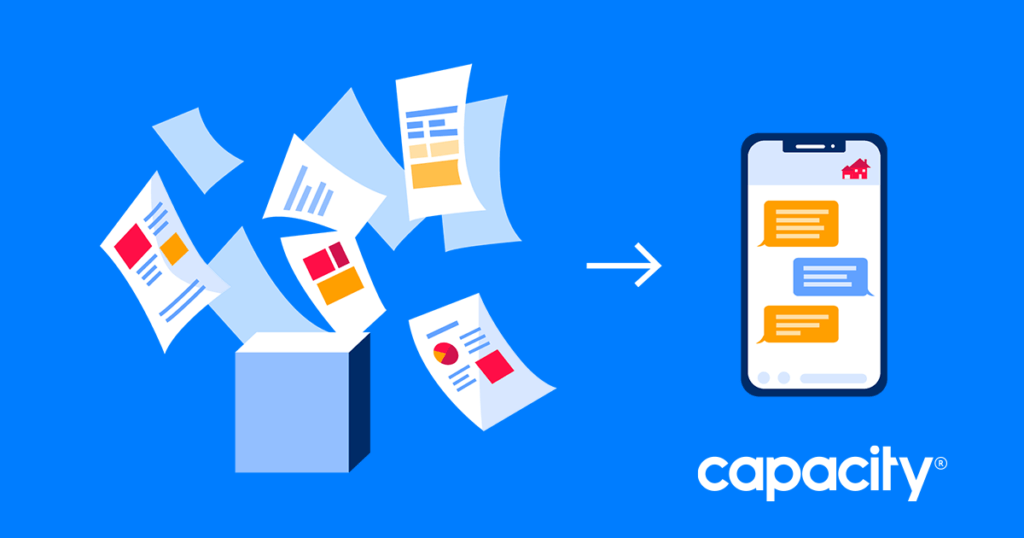Forty-seven days is the average time to close a loan, but eager consumers expect a much quicker turnaround. Using an AI platform such as Capacity, mortgage companies can reduce the time and cost of securing a mortgage and even ensure same-day approvals.
Artificial intelligence (AI) and automation, in particular, speed up the time-consuming tasks of gathering, reviewing, and verifying mortgage documents. The entire mortgage process becomes an assembly line that increases productivity and communication and improves the customer experience with technologies like chatbot functionality.

AI and automation can also replace optical character recognition (OCR), which grabs data and assigns it to the correct field, by interpreting mortgage application information with greater precision and speed. Plus, AI can read and react to text from emails, physical files, and other formats.
There are even more benefits of AI and automation.
Some mortgage lenders use external agencies to process jobs, while third-party call centers help with customer service. An AI-powered support automation platform like Capacity allows lenders to communicate with customers in-house, improving compliance with privacy regulations and keeping costs down.
Indeed, lenders can become a single source or one-stop-shop for home buyers by offering additional services such as referrals to real estate agents, inspectors, and accredited contractors. Clients won’t have to go anywhere else to meet their home-buying and loan processing needs, providing lenders with a competitive advantage in any work environment.
Below, you will learn more about the buyer’s journey, where AI and automation can help, and the future of loan officers in the digital mortgage age.
The borrower’s journey.
The mortgage loan process can overwhelm many borrowers. There are a series of steps that make up the loan origination process. We list them below:
- Pre-approval
Unless a borrower can pay cash, it’s critical to secure a loan with competitive mortgage rates. In an overcrowded market, a pre-approval always helps. Showing realtors verification of a pre-approval gives borrowers a better chance of securing the home of their dreams.
- Shopping for a home
Home-searching is when borrowers have to produce a budget, and some may use financial advisors or a mortgage loan calculator to determine their purchase limits. Buyers may also document a list of must-haves vs. nice-to-haves. Next, borrowers whittle down listings to select favorites, and real estate agents make offers.

- Mortgage application
This stage is perhaps the most critical in the mortgage loan buyer’s journey because it’s about solidifying the numbers. Borrowers must bring income, debt, asset, and financial services documentation to lenders like commercial banks, credit unions, and mortgage companies. It is also the time to get any questions and issues out of the way before borrowers move further along the journey.
Capacity features an AI-powered help desk with chatbot functionality that lets lenders communicate with customers about different types of loans during the application stage and throughout the mortgage life-cycle. This feature has proved invaluable during the COVID-19 pandemic where face-to-face interactions between lenders and borrowers weren’t possible.
- Loan processing
Waiting on a loan approval is another step of the process. Mortgage underwriters and loan originators must verify all financial information provided by a borrower and check credit reports for collections, bankruptcies, and late payments. An underwriter also has to confirm information associated with savings accounts, debt obligations, and employment.
- Loan underwriting
The mortgage underwriter is an indispensable part of the buyer’s journey. The underwriter can only approve a loan to close for borrowers who have passed all verification checks and have met the financial status requirements. Not to mention, the underwriter has to ensure a borrower can afford to pay the mortgage with funds left over for bills, living expenses, and any future increase in interest rates.
Borrowers are eager to move forward, as are mortgage lenders. When borrowers complete the buyer’s journey, it is a win-win for both parties. Yet, one of the primary concerns is how quickly all parties can get through the mortgage process. AI and automation can help. For example, these technologies can pre-fill and analyze application forms, saving the lender time and resources. AI can also identify application exceptions to enhance processing accuracy and alert mortgage loan officers about any issues with an application.
- Closing
Mortgage closing, or settlement, can involve a great deal of paperwork prone to human error on both sides. AI and automation can help detect errors while pre-filling forms to speed up the process.
The augmented loan officer.
What does the future of loan officers look like? As AI and automation strengthen the mortgage process, will these technologies leave any room for officers? The answer is yes because it still takes people to create trust and build relationships with borrowers.
Loan officers are there to originate loans. AI and automation allow a commercial loan officer to personalize interactions with customers and focus on more complex issues that offer strategic value. An AI-powered support automation platform like Capacity optimizes loan processing because it improves communication between lenders and borrowers throughout the mortgage lending process and enhances customer satisfaction.








































